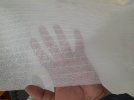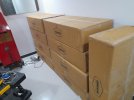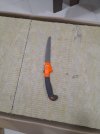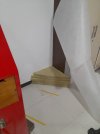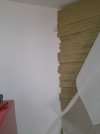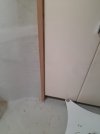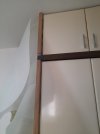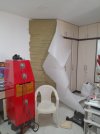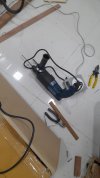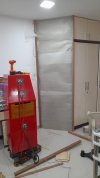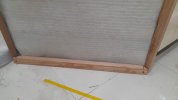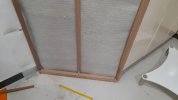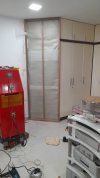Yelamanchili manohar
Well-Known Member
Hi all

I guess I've been ranting for years about treating my room, and also going active. The going active journey might be a bit delayed as 2 of my tube amps are away for a regular service. And iam also undecided about the 3 way active crossover. So that will be for later, and will be a seperate post completely.
So I thought I'd just start with my room treatment plans and share my everyday progress. I will also be posting links of the material Iam using .
Iam no expert at acoustic treatment, thus I've talked to a reliable supplier, who also undertakes treatment projects. And I have highlighted the issues I've been facing. And he has suggested the materials to be used for my project. Besides I've done a fair bit of research over the last one year, so I guess I know my marbles when it comes to the voodoodo of acoustic treatment.
Room size - 11.5 x 15 feet
Speaker placement- along the longer 15 feet wall ( why along the longer wall, which is the unconventional way of placing speakers , please read below )
)
I have been very fortunate to be blessed with some great imaging in my small 11.5 x 15 feet room. Though I have severe bass issues low down, the imaging is somehow just great. I can list down the things that improved my imaging as I tried several different things :
1. Speaker placement: My speakers are not symmetrically placed, as I have a small extension, opening into the dresser behind the left speaker. Thus, when I played with positioning to get the best imaging I could, I ended up with the left speaker being about 2 inches farther from the seating position, than the right speaker. And the toe in on my right speaker ( there is a window just to the side ) is ever so slightly lesser than my left speaker. The visual disparity is visibly very evident. So I darken the room, and when playing music, the speakers just disappear.
2. Again speaker placement : In my small room I experimented placing the speakers along the long wall, as well as the short wall. And very surprisingly, I preferred the long wall placement. The speakers are now 11 feet apart, tweeter to tweeter. And the tweeter is around 130 cms from the wall behind the speakers. Almost 1 meter away from side walls. And my seating distance from the speakers is just about 8 feet. This wide placement of the speakers with a large toe-in ( I almost can only see the front baffles of the speakers and not their sides ), has reduced side wall reflections very well. And the sound stage is huge - 15 feet wide , with a very good perception of depth, and the imaging is as sharp as a pins head. On many many tracks, the side walls completely disappear, with no perception of the size of the room at all. Many instruments infact sound outside the plain of the speakers.
The tweeters are almost a foot above my ear height. Yes, that is right, the tweeters are not at my ear height when sitting down. This has given me an excellent sense of height to the sound stage. So all in all, my room will always trigger a big laugh from any friends who visit.
3. Vibration control : adding the isoacoustics gaia's under my previous pmc speakers, really improved the imaging. So iam a believer that these things work for me. However, my new speakers are really heavy at 120 kgs each, and I don't have the budget to buy something that can support that kind of weight. So Iam planning a short cut, and will report back once done.
But I can easily say that the biggest gain was with the placement of the speakers, though my setup goes against the established wisdom on the net

Coming back on topic now
Biggest challenge : This is my daughters room, so will still have to be aesthetically pleasing with the end result. My daughters favourite colour is teal or turqouise. So the colour theme for the room is turquoise and navy blue. I have already dismantled my daughters queen bed today. And will be replacing with a sofa cum bed from IKEA, as my daughter never sleeps here, and is mostly used by my father in law on his visits. So comfort is not really a factor

So here is the bed in navy blue :
https://www.ikea.com/in/en/p/friheten-3-seat-sofa-bed-skiftebo-blue-10431565/
Below are the biggest issues I have :
1. Bass suck outs from 65 to 110 hz : Due to quarter wave cancellations.
The center of the 10 inch bass driver is 130 cms from the back wall, 100 cms from side wall and 90 cms from the floor. I didn't measure from the ceiling though .
.
With all these three distances being between 90 to 130 cms, iam having severe quarter wave cancellations in the 65 to 105 hz bass range. And this is readily apparent with a sense of loss of dynamics, and one note bass.
THE FIX : i have been suggested to go for the heaviest density geo wool at 160 kgs / Cu.M. I will be building 2 corner traps from floor to ceiling, each 2x2 feet. And one 8 feet wide and one foot deep, floor to ceiling trap immediately behind my listening position. This higher density wool is apparently not suitable for making a broad band absorber ( I will revisit this topic below ). And is to be used only for bass traps. As it apparently only absorbs in the lower bass region, and starts loosing it's absorbing efficiency above 200hz, due to its gas flow rate. Thus, it acts as a reflector at higher frequencies and will not make my small room overdamped.
Below is the absorbing material :
https://www.auralexchange.com/product/nankarrow-geowool-6-pcs-1-2m-x-0-6m-mineral-wool-acoustic-insulation-board/?attribute_pa_density=160kg-m³
Below is the wrapping fabric to retain all the fibers in place:
https://www.auralexchange.com/produ...ttribute_pa_size=10m-x-1m-roll-10sqm-107-sqft
I've received the above already, and it is very breathable and close to being transparent. The bass traps will be covered with this first. With a finishing layer of the below in turquoise colour as planned :
https://www.auralexchange.com/produ...eilings-panels/?attribute_pa_colour=turquoise
Below are the sal wood frames on which the finishing fabric will be stapled :
https://www.auralexchange.com/produ..._size=3650mm-x-50mm-x-38mm-12ft-x-2in-x-1-5in
2. Room bass modes : Ive used a DSpeaker antimode 2.0 before, and it easily chopped off the bass peaks I was having due to room induced peaks. Though with bass treatment I expect to have smoother bass response, but these peaks might not be fully cancelled, thus will be using the either the DSpeaker antimode 2.0 or dirac live correction to cancel the peaks still left after bass treatment.
3. Too much echo and reverb: I've been suggested to use rocksul safe and silent 370 (80 kgs /Cu.M ) and with a panel depth of 4 inches as wide band absorbers at first reflection points including the ceiling clouds. Please bear in mind that the geowool of 160 kgs density that iam using for bass traps is not recommended here. A lot of small rooms apparently sound dampened, as the higher frequencies are absorbed first, and the bass and mids left on their own (I believe it happens when one uses foam based absorbers , which probably doesn't do much in the lower mid range and below ) Resulting in a completely skeweed room. Thus, I have been suggested to start with addressing the bass first with the geowool 160 and then start working up the frequency range from here with the rocksul safe and silent. ( I will eventually come to why iam not using much of diffusion to keep the room alive, which is a very important thing for me )
https://www.auralexchange.com/product/roxul-rockwool-safe-n-silent-pro-acoustic-insulation-boards/
However, I have read to do the ceiling clouds first, before even attempting to touch the side walls. And only once done with the ceiling clouds, I've been advised to very cautiously add these broad band panels to the side walls.
4. Improving imaging with diffusion/ absorption : My speakers are great at imaging already. And just want to improve it further. I've read that absorption helps more than diffusion in smal rooms, as diffusion needs distance from the listener to really work. And the usual minimal recommended distance is 10 feet. As I will probably have that distance only at the front wall, will experiment there first and see.
Below is the diffuser I have in my sights : ( will order 2 panels to make it 4 feet wide atleast )
https://www.amazon.in/gp/product/B08X6HDKG7/ref=ox_sc_saved_image_3?smid=A3SWZ8R1PUKMB&psc=1
So there is the start finally, I will be getting the 14 bags of geowool to start with tomorrow. Rest all materials are already here. And I have borrowed 4 nos of 4x2 feet broad band absorbers from a very good friend of this very same parish to experiment in different positions, and I plan on retaining them. Will keep updating with my daily progress from tomorrow onwards, though I really doubt if I could really make any sense of the measurements I get from REW. As I also intend to keep measuring ( Rta 30 reverb time ) as well a listening to see if iam not going in the right direction. Please wish me good luck
I guess I've been ranting for years about treating my room, and also going active. The going active journey might be a bit delayed as 2 of my tube amps are away for a regular service. And iam also undecided about the 3 way active crossover. So that will be for later, and will be a seperate post completely.
So I thought I'd just start with my room treatment plans and share my everyday progress. I will also be posting links of the material Iam using .
Iam no expert at acoustic treatment, thus I've talked to a reliable supplier, who also undertakes treatment projects. And I have highlighted the issues I've been facing. And he has suggested the materials to be used for my project. Besides I've done a fair bit of research over the last one year, so I guess I know my marbles when it comes to the voodoodo of acoustic treatment.
Room size - 11.5 x 15 feet
Speaker placement- along the longer 15 feet wall ( why along the longer wall, which is the unconventional way of placing speakers , please read below
I have been very fortunate to be blessed with some great imaging in my small 11.5 x 15 feet room. Though I have severe bass issues low down, the imaging is somehow just great. I can list down the things that improved my imaging as I tried several different things :
1. Speaker placement: My speakers are not symmetrically placed, as I have a small extension, opening into the dresser behind the left speaker. Thus, when I played with positioning to get the best imaging I could, I ended up with the left speaker being about 2 inches farther from the seating position, than the right speaker. And the toe in on my right speaker ( there is a window just to the side ) is ever so slightly lesser than my left speaker. The visual disparity is visibly very evident. So I darken the room, and when playing music, the speakers just disappear.
2. Again speaker placement : In my small room I experimented placing the speakers along the long wall, as well as the short wall. And very surprisingly, I preferred the long wall placement. The speakers are now 11 feet apart, tweeter to tweeter. And the tweeter is around 130 cms from the wall behind the speakers. Almost 1 meter away from side walls. And my seating distance from the speakers is just about 8 feet. This wide placement of the speakers with a large toe-in ( I almost can only see the front baffles of the speakers and not their sides ), has reduced side wall reflections very well. And the sound stage is huge - 15 feet wide , with a very good perception of depth, and the imaging is as sharp as a pins head. On many many tracks, the side walls completely disappear, with no perception of the size of the room at all. Many instruments infact sound outside the plain of the speakers.
The tweeters are almost a foot above my ear height. Yes, that is right, the tweeters are not at my ear height when sitting down. This has given me an excellent sense of height to the sound stage. So all in all, my room will always trigger a big laugh from any friends who visit.
3. Vibration control : adding the isoacoustics gaia's under my previous pmc speakers, really improved the imaging. So iam a believer that these things work for me. However, my new speakers are really heavy at 120 kgs each, and I don't have the budget to buy something that can support that kind of weight. So Iam planning a short cut, and will report back once done.
But I can easily say that the biggest gain was with the placement of the speakers, though my setup goes against the established wisdom on the net
Coming back on topic now
Biggest challenge : This is my daughters room, so will still have to be aesthetically pleasing with the end result. My daughters favourite colour is teal or turqouise. So the colour theme for the room is turquoise and navy blue. I have already dismantled my daughters queen bed today. And will be replacing with a sofa cum bed from IKEA, as my daughter never sleeps here, and is mostly used by my father in law on his visits. So comfort is not really a factor
So here is the bed in navy blue :
https://www.ikea.com/in/en/p/friheten-3-seat-sofa-bed-skiftebo-blue-10431565/
Below are the biggest issues I have :
1. Bass suck outs from 65 to 110 hz : Due to quarter wave cancellations.
The center of the 10 inch bass driver is 130 cms from the back wall, 100 cms from side wall and 90 cms from the floor. I didn't measure from the ceiling though
With all these three distances being between 90 to 130 cms, iam having severe quarter wave cancellations in the 65 to 105 hz bass range. And this is readily apparent with a sense of loss of dynamics, and one note bass.
THE FIX : i have been suggested to go for the heaviest density geo wool at 160 kgs / Cu.M. I will be building 2 corner traps from floor to ceiling, each 2x2 feet. And one 8 feet wide and one foot deep, floor to ceiling trap immediately behind my listening position. This higher density wool is apparently not suitable for making a broad band absorber ( I will revisit this topic below ). And is to be used only for bass traps. As it apparently only absorbs in the lower bass region, and starts loosing it's absorbing efficiency above 200hz, due to its gas flow rate. Thus, it acts as a reflector at higher frequencies and will not make my small room overdamped.
Below is the absorbing material :
https://www.auralexchange.com/product/nankarrow-geowool-6-pcs-1-2m-x-0-6m-mineral-wool-acoustic-insulation-board/?attribute_pa_density=160kg-m³
Below is the wrapping fabric to retain all the fibers in place:
https://www.auralexchange.com/produ...ttribute_pa_size=10m-x-1m-roll-10sqm-107-sqft
I've received the above already, and it is very breathable and close to being transparent. The bass traps will be covered with this first. With a finishing layer of the below in turquoise colour as planned :
https://www.auralexchange.com/produ...eilings-panels/?attribute_pa_colour=turquoise
Below are the sal wood frames on which the finishing fabric will be stapled :
https://www.auralexchange.com/produ..._size=3650mm-x-50mm-x-38mm-12ft-x-2in-x-1-5in
2. Room bass modes : Ive used a DSpeaker antimode 2.0 before, and it easily chopped off the bass peaks I was having due to room induced peaks. Though with bass treatment I expect to have smoother bass response, but these peaks might not be fully cancelled, thus will be using the either the DSpeaker antimode 2.0 or dirac live correction to cancel the peaks still left after bass treatment.
3. Too much echo and reverb: I've been suggested to use rocksul safe and silent 370 (80 kgs /Cu.M ) and with a panel depth of 4 inches as wide band absorbers at first reflection points including the ceiling clouds. Please bear in mind that the geowool of 160 kgs density that iam using for bass traps is not recommended here. A lot of small rooms apparently sound dampened, as the higher frequencies are absorbed first, and the bass and mids left on their own (I believe it happens when one uses foam based absorbers , which probably doesn't do much in the lower mid range and below ) Resulting in a completely skeweed room. Thus, I have been suggested to start with addressing the bass first with the geowool 160 and then start working up the frequency range from here with the rocksul safe and silent. ( I will eventually come to why iam not using much of diffusion to keep the room alive, which is a very important thing for me )
https://www.auralexchange.com/product/roxul-rockwool-safe-n-silent-pro-acoustic-insulation-boards/
However, I have read to do the ceiling clouds first, before even attempting to touch the side walls. And only once done with the ceiling clouds, I've been advised to very cautiously add these broad band panels to the side walls.
4. Improving imaging with diffusion/ absorption : My speakers are great at imaging already. And just want to improve it further. I've read that absorption helps more than diffusion in smal rooms, as diffusion needs distance from the listener to really work. And the usual minimal recommended distance is 10 feet. As I will probably have that distance only at the front wall, will experiment there first and see.
Below is the diffuser I have in my sights : ( will order 2 panels to make it 4 feet wide atleast )
https://www.amazon.in/gp/product/B08X6HDKG7/ref=ox_sc_saved_image_3?smid=A3SWZ8R1PUKMB&psc=1
So there is the start finally, I will be getting the 14 bags of geowool to start with tomorrow. Rest all materials are already here. And I have borrowed 4 nos of 4x2 feet broad band absorbers from a very good friend of this very same parish to experiment in different positions, and I plan on retaining them. Will keep updating with my daily progress from tomorrow onwards, though I really doubt if I could really make any sense of the measurements I get from REW. As I also intend to keep measuring ( Rta 30 reverb time ) as well a listening to see if iam not going in the right direction. Please wish me good luck
Last edited:


